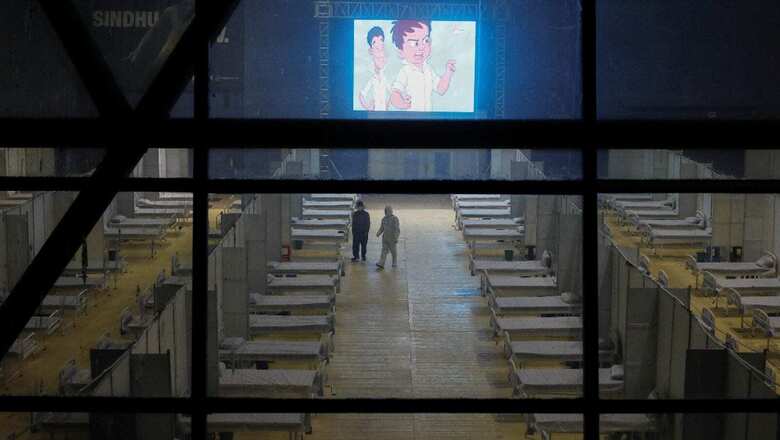
views
Omicron has led to an unprecedented rise in Covid-19 across the country. Metropolitans Delhi and Mumbai in Maharashtra are reporting high infections and rise in numbers. The numbers ring back fears from the second wave, when healthcare systems were strained beyond measures and beds were not available for a huge number of patients.
However, this time, state governments are attempting to work ahead of the curve to ensure such a healthcare collapse does not occur again. According to experts, while hospitalisation rates are rising in Delhi, the situation is not ‘alarming yet’.
The Omicron variant’s nature is attributed increased transmissibility, especially for breakthrough cases. However, the disease severity of the variant is still under question, with many countries reporting the cases to be mild. However, such an exponential rise in cases could still spur an increased number of people in hospitals, which is the trend being witnessed in the United States right now.
India on January 9 logged 552 new cases of Omicron, taking the total tally of such infections to 3,623 across 27 states and UTs so far. Maharashtra recorded the maximum number of 1,009 cases followed by Delhi at 513, Karnataka 441, Rajasthan 373, Kerala 333 and Gujarat 204. Meanwhile, a total of 1,59,632 new coronavirus infections were reported in a day, the highest in 224 days, while the active cases increased to 5,90,611, the highest in around 197 days, according to the data updated at 8 am. The death toll climbed to 4,83,790 with 327 fresh fatalities, the data stated.
In an India Today report (dated January 7) on the capital’s hospital numbers, Dr Vivek Nangie, head of Pulmonogy at Max Saket told the publication that “hospitalisations are very slow at the moment, but we have enough capacity in our facility. So, there is no need to panic.”
According to the report, the number of beds occupied in Delhi hospitals had grown by January 7 compared to the last two days. 945 of the 12,025 Covid beds were occupied on January 5. There were 11,405 oxygen hospital beds available, with 921 of them filled. Only 187 of the 3,303 ICU beds were filled. In addition, 65 of the 1,523 ventilator-equipped ICU beds were filled.
The figures rose slightly the next day. On January 6, there were 1,125 Covid beds in use, 1,099 oxygen beds in use, and 213 Covid ICU beds in use. The number of persons using ventilators has also increased to 72.
On January 9, according to the Delhi Corona App, out of the total 14,314 Covid-19 beds available, 1,674 were occupied, while 12,640 remain vacant. 1,552 oxygen beds are occupied out of the total 13,269 oxygen beds available, and 318 ICU beds are occupied out of the 4,090 such beds available.
98 Covid-19 ICU beds are occupied out of the 1,818 ones available while 1,720 remain vacant.
Meanwhile, Delhi has also begun to augment its healthcare facilities to prepare for a dire situation. The AAP government has decided to increase 5,650 normal beds and 2,075 ICU beds for coronavirus patients in 14 hospitals, along with 2,800 beds in eight COVID-care centres, Health Minister Satyendar Jain said on Saturday. In a statement, he said the Delhi government is making all necessary arrangements in view of the rising coronavirus cases and the situation is normal.
While the number of cases in Delhi has skyrocketed, the hospitalisation rate has fallen, from 6.6 percent on January 1 to 4.81 percent on January 7, according to a report in the New Indian Express. Dr. Suresh Kumar, head of Lok Nayak Hospital, patients admitted are largely those who have comorbidities and have not been vaccinated.
“So far, the cases have been moderate, and only a few people have required oxygen assistance,” he told TNIE.
Maharashtra, which imposed fresh Covid-19 curbs on the state starting this Monday, said the move was aimed at preventing a strain on healthcare services amid the projected rise of infections in the state.
“We have been fighting the virus for the last two years and have successfully dealt with two waves of the pandemic by taking cautious steps. The virus, in a different avatar, has been spreading rapidly,” the CM Uddhav Thackeray said. “Instead of discussing whether it is mild or serious, we need to take steps to stop it, else our health infrastructure will be under tremendous pressure,” he said.
The report mentions that home isolation increased from roughly 1.22 lakh on December 25 to 5.85 lakh on January 6 in Maharashtra. During this time, hospitalizations increased from 905 to 1,368.
The current rise in Uttar Pradesh is faster than the second wave, but hospitalisation is not as high, the report mentions. According to data from the health department, the percentage of hospitalisation during the second wave was 9%. It’s currently about 2%, a health official said.
Between December 29 and January 6, hospitalizations in Madhya Pradesh increased by 174%. However, this could be deceiving, given that active cases increased by 706 percent during this time span. On January 6, 200 (0.36%) of the 56,171 hospital beds for COVID patients were occupied, the report says.
Although the number of cases in Punjab is increasing, the hospitalisation rate for active cases has decreased from over 6% on December 30 to 1.01 percent on January 6. Fearing the worst, the state administration doubled bed capacity, yet just about 1% of them are filled.
Read all the Latest India News here




















Comments
0 comment